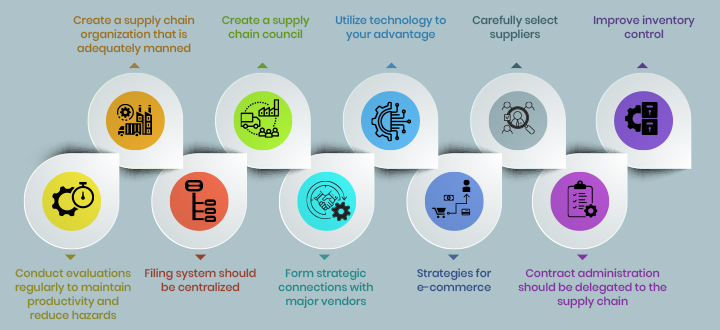
ACL Digital
10 Best Practices to Enhance Your Supply Chain Management
Various corporate units, outside suppliers, and internal supply management team members are all involved in supply chain management. The appropriate people, making the right choices based on the correct data and structure, are required for effective supply chain management. Doing what you’ve always done—even if you do it exceptionally well—is no longer satisfactory in today’s economic climate. You (and many other supply chain managers) are under strain to keep costs down and generate results under difficult conditions. Therefore you must adapt rather than merely enhance your operations.
For this, businesses may enhance their supply chain management in various ways to optimize efficiency and productivity, save costs, and deliver a greater user experience.

1. Create a supply chain organization that is adequately manned
2. Create a supply chain council
3. Utilize technology to your advantage
Too many businesses choose software that they believe would improve their efficiency and then build their routines and procedures around it. Instead, they should examine the operations that need improvement first and then choose the technology that best meets those needs.
Supervisors must realize that “the system” is supposed to assist them in better managing their supply chains. They should figure out a method to employ technology to generate useful data without resorting to numerous “workarounds”. This can be done to retrieve and examine the data.
4. Carefully select suppliers
It is at the core of good supply chain management, and you’ll achieve even greater outcomes if you work together. Further, skill, innovation, internal and external cooperation, and process improvement are important components of a successful supply chain.
Hence, soliciting input from your suppliers on any aspect of your internal business or function may impact the success of your projects or procedures. This way, you’ll benefit from simpler operations, lower expenses, and better response with collaborative strategic sourcing.
5. Improve inventory control
Inventory management, like demand forecasting, is an important aspect of a well-functioning supply chain. Supply chain managers must assess ideal stock levels for present and potential demand and implement restocking best practices once a firm can accurately estimate demand (e.g., ad-hoc supply restocking or one-time, standing, or blanket bulk purchases).
Further, stock transparency lets you predict more correctly. This helps to analyse demand-specific parameters that can give significant insights into a company’s inventory management strategy and enable data-driven planning and decision-making.
6. Conduct evaluations regularly to maintain productivity and reduce hazards
7. Filing system should be centralized
Keeping track of bills, customs paperwork, inspection reports, purchase orders, and other supply chain documents can be difficult. Hence, due to soiled operations and departments, supply chain documentation frequently suffers from inconsistencies, disconnects. This can lead to confusion, a decrease in reactivity, and an increase in mistakes.
Moreover, investing in a system that acts as a centralized hub for all supply chain paperwork and a comprehensive source for decision-makers to examine and manage all of a company’s supply chain operations. This may improve end-to-end procedures while reducing ad-hoc, disjointed document management.
8. Form strategic connections with major vendors
Long after a contract has been signed, best-in-class organizations collaborate closely with their suppliers. This is known as “supplier relationship management” in most areas nowadays. However, this indicates just one-way communication (telling the supplier how to do it).
Two-way communication is more productive because it demands both the buyer and the vendor to manage the connection together. This best practice could be better described as “alliance management,” with officials from two sides cooperating to improve the buyer/supplier relationship. Also, you’ll be able to harness the abilities of your supply base to produce long-term value while always striving for development.
This can be possible if you have a solid alliance management program in place.
9. Contract administration should be delegated to the supply chain
Potential savings are frequently discussed, but they are rarely achieved. This is frequently due to a misunderstanding or a failure to follow through. Bring contract management within the supply chain solution to avoid this. This allows your supply chain manager to focus expenditure where it can save money and minimize risk the most.
10. Strategies for e-commerce
Conclusion
Organizations must use proactive supply chain management procedures to ensure sustained operations in an era of rapid change. To remove kinks in the supply chain while assisting decision-makers in implementing enterprise-wide goals, effective technologies are required to forecast future challenges. Also helps to mitigate risks, and overcome obstacles.
Working with a cloud pioneer and expert in supply chain solutions is critical for identifying potential for improvement and resolving challenges. The techniques listed above aren’t exhaustive of everything top-tier supply chain management executives are doing right now. On the other hand, this list offers some suggestions and maybe a road map for a supply chain organization that wants to be seen as valuable and relevant to its parent firm.





